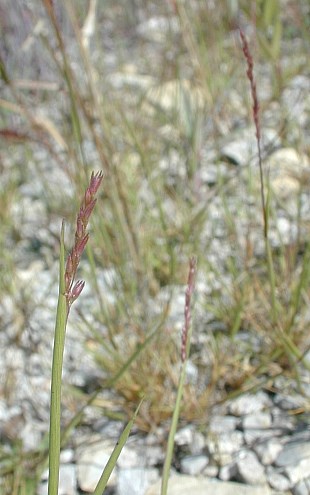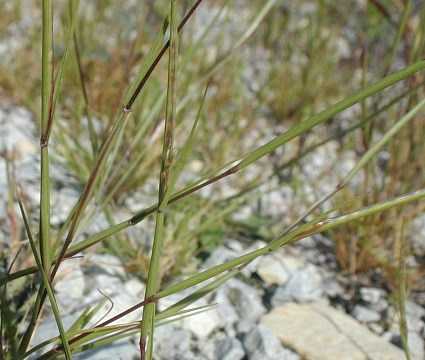Description: This grass is a summer annual that is often tufted at the base, sending up multiple unbranched culms with alternate leaves. A typical tufted plant is about 5-10" tall and two-thirds as much across; larger plants have been observed, but this is uncommon. There are usually remnants of dried out leaves at the base. Each hairless culm is stiff, wiry, and often flattened, becoming dark purple with age. The leaf blades are up to 4 cm. (1½") long and 2 mm. across; they are ascending to erect, dull light green, and hairless, except for a few long hairs near the base of some leaves. The leaf sheaths are dull light green, hairless, shorter than the internodes, and swollen. Each node consists of a small ring that is dark and hairless. Each culm terminates in a spike-like panicle that is only partially exerted from the uppermost sheath; other upper sheaths also have such panicles, which are either completely hidden or partially exerted. A typical panicle is about 3 cm. long and very slender; it has a few short branches that are erect. The spikelets of the panicle are dull greenish pink to shiny purplish pink. Each spikelet is about 2 mm. long, consisting of a pair of glumes and a single lemma with a palea. The glumes, lemma, and palea are about 2 mm. long, hairless, lanceolate, and folded along the middle. The glumes are usually pink or purple, while the lemma and palea are variously colored, depending on their maturity. The blooming period occurs during the early fall. Shortly afterward, the foliage and spikelets of each plant become light tan. Each fertile spikelet produces a tiny grain that is about 1 mm. long and ovoid-oblongoid in shape; it is small enough to be blown about by the wind. The root system is fibrous. This grass reproduces by reseeding itself.

Cultivation:
The preference is full sun, dry conditions, and sterile soil that
contains abundant gravel or sand. This grass is intolerant of
competition from taller plants. It is quite tolerant of drought because
of its C4 metabolism.
Range & Habitat:
The native Small Dropseed is occasional in the northern half of
Illinois, but
uncommon or absent in the southern half of the state (see Distribution
Map). Habitats include rocky openings in upland woodlands,
limestone glades, hill prairies, gravelly or sandy areas along
railroads, roadsides, pastures, and barren waste areas. Dry sunny areas
with a history of disturbance are preferred.
Faunal Associations: Little information about floral-faunal relationships is available for this species. The seeds may be eaten by the Field Sparrow, Tree Sparrow, and other granivorous songbirds, particularly during the winter. The foliage of Small Dropseed provides poor and scanty forage for cattle and other hoofed mammalian herbivores.

Photographic
Location:
A gravelly area along a railroad in Champaign, Illinois.
Comments:
Small Dropseed develops late in the year and is easily overlooked. It
is often found in the same habitats as Sporobolus vaginiflorus
(Sheathed Dropseed), which is another summer annual with a very similar
appearance. This latter species has larger spikelets (about 4 mm. in
length) that are often dark purple; its glumes and lemmas are more
narrow and pointed than those of Small Dropseed. Both of these small
grasses have spike-like panicles that are hidden, in whole or in part,
by the sheaths. While this characteristic may seem odd, the florets of
the hidden spikelets are probably self-fertile. Other common names of Sporobolus
neglectus include Puffsheath Dropseed, Small Rush Grass, and
Poverty Grass. However, the last common name is sometimes applied to Sporobolus
vaginiflorus and other grass species.